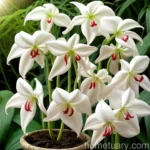Bladder Campion (Silene vulgaris): A Comprehensive Guide

Bladder campion (Silene vulgaris) is a delightful, delicate plant that has captured the interest of botanists, gardeners, and nature enthusiasts around the world. Its charming appearance and various uses make it a valuable addition to gardens and landscapes.
In this comprehensive guide, we’ll delve into the many facets of bladder campion, from its cultural significance to its ecological role, and provide insights into its cultivation, care, and folklore. Whether you’re a seasoned gardener or a budding plant enthusiast, this in-depth exploration of bladder campion will certainly pique your interest and deepen your understanding of this captivating plant.
What is Bladder Campion (Silene vulgaris)?
Bladder campion, scientifically known as Silene vulgaris, is a herbaceous perennial plant belonging to the Caryophyllaceae family. This plant is also commonly referred to as Maidens’ tears, Bladder silene, and Cowbell.
With its distinctive white or pink flowers that resemble little bubbles or, as the name suggests, the shape of a bladder, bladder campion is a visually striking addition to any garden. The plant typically reaches a height of 30–80 cm and thrives in a variety of habitats, including grasslands, meadows, and roadsides.
Key Takeaways
Before delving into the various aspects of bladder campion, let’s outline the key takeaways about this captivating plant:
- Scientific Name: Silene vulgaris
- Common Names: Bladder campion, Maidens’ tears, Bladder silene, Cowbell
- Habitat: Thrives in grasslands, meadows, and roadsides.
- Appearance: Delicate white or pink flowers resembling the shape of a bladder.
- Cultural Significance: Has folklore and traditional uses in various cultures.
- Ecological Role: Serves as an important wildlife habitat and attracts pollinators.
- Cultivation: Can be grown in containers or as part of landscape design.
- Uses: Offers culinary, medicinal, and ornamental benefits.
Now that we’ve established a brief overview, let’s explore the many dimensions of bladder campion in detail.
Cultivation
Cultivating bladder campion provides a delightful opportunity to integrate this charming plant into your outdoor space. Whether you have a garden, balcony, or a larger landscape to work with, understanding the requirements for its successful cultivation is crucial. Let’s explore the various factors that influence the growth and development of bladder campion.
Water
Bladder campion, being a resilient plant, is well-adapted to varying levels of moisture. However, it thrives best in well-drained soil. When establishing bladder campion in your garden or landscape, ensure that the soil is consistently moist but not waterlogged.
Growing Tip: Water the plant at the base to prevent moisture-related diseases and to encourage healthy root development.
Sunlight
In terms of sunlight requirements, bladder campion displays a preference for full sun to partial shade. When selecting the ideal location for planting, choose an area that receives ample sunlight for the majority of the day, while also offering some relief from intense midday sun during the hottest months.
Growing Tip: In regions with exceptionally hot climates, provide partial shade during the hottest part of the day to prevent heat stress.
Fertilizer
As a relatively low-maintenance plant, bladder campion does not require heavy feeding. However, incorporating organic matter into the soil during the initial planting stage can promote healthy growth and blooming. A balanced, slow-release fertilizer applied in early spring can provide the necessary nutrients for robust growth.
Growing Tip: Use a fertilizer with a balanced NPK ratio to support overall plant health and flower production.
Soil
Bladder campion adapts well to a range of soil types, including loamy, sandy, and clay soils. However, it thrives best in well-draining, moderately fertile soil with a slightly alkaline to neutral pH. Prior to planting, amending the soil with organic matter can improve its texture and fertility.
Growing Tip: Perform a soil test to assess the pH and fertility levels, and make necessary amendments based on the results.
Pruning
While bladder campion generally requires minimal pruning, deadheading the spent flowers can encourage prolonged blooming and prevent self-seeding. Additionally, removing any damaged or withered foliage promotes the plant’s overall vigor and aesthetics.
Growing Tip: Prune the plant in early spring to remove any winter damage and encourage new growth.
Propagation
Propagation methods for bladder campion include both seed sowing and division. These techniques offer the opportunity to expand your plant collection, share bladder campion with fellow gardening enthusiasts, or fill additional areas of your garden with this captivating plant.
Seeds
Sowing bladder campion seeds directly in the garden bed or in containers is a straightforward method of propagation. Optimal seed germination occurs when the soil temperature is consistently warm, and the seeds are kept lightly moist until germination occurs.
Propagation Tip: Sow the seeds in early spring or late summer for best results, and cover them lightly with soil to aid in germination.
Division
Dividing mature clumps of bladder campion allows you to create new plants from established ones. This technique is particularly useful for rejuvenating overcrowded plants and expanding your bladder campion population.
Propagation Tip: Perform division in early spring or late fall when the plant is entering a period of dormancy to minimize stress and promote successful establishment.
Container Popularity
Beyond its appeal in garden beds and landscape settings, bladder campion also garners popularity as a container plant. The delicate, cascading nature of its foliage and flowers make it a lovely addition to outdoor containers, hanging baskets, and window boxes.
Container Selection
When selecting a container for bladder campion, opt for a pot with adequate drainage holes to prevent waterlogging. The container size should accommodate the plant’s root system and provide ample space for growth.
Container Planting Tip: Consider using a lightweight, well-draining potting mix tailored for flowering plants to ensure optimal growing conditions.
Common Diseases
Like any plant, bladder campion is susceptible to certain diseases and pests that can affect its overall health and vitality. Being aware of common diseases and their corresponding preventive measures is vital for maintaining a thriving bladder campion population.
Disease Diagnosis
Common diseases that may affect bladder campion include powdery mildew, leaf spot, and root rot. Monitoring the plant for any signs of discoloration, wilting, or unusual spotting can aid in early disease detection and prompt intervention.
Diagnosis Tip: Regularly inspect the foliage, stems, and soil for any signs of disease, and promptly address any issues to prevent their spread.
Common Pests
Pests such as aphids, spider mites, and leaf miners are known to feed on bladder campion foliage and can impact the plant’s overall vigor. Implementing integrated pest management practices can help mitigate pest-related issues.
Pest Control Tip: Encourage natural predators such as ladybugs and lacewings, and use insecticidal soaps as a targeted intervention for pest control.
Botanist’s Tips
As a plant with rich cultural history and ecological significance, bladder campion offers a myriad of intriguing aspects that captivate the attention of botanists and plant enthusiasts. Here are some insightful tips for exploring the unique characteristics and value of bladder campion from a botanical perspective:
-
Explore Folklore: Delve into the folklore and traditional uses of bladder campion across different cultures and regions, uncovering the plant’s symbolic significance and historical resonance.
-
Study Ecosystem Interaction: Investigate the role of bladder campion in supporting wildlife and contributing to the overall ecological balance within its natural habitat.
-
Document Growing Habit: Record and analyze the growth habits, flowering patterns, and adaptability of bladder campion in various environmental conditions.
-
Collaborate on Conservation Efforts: Engage in collaborative conservation initiatives aimed at protecting and preserving bladder campion in its native habitats.
Fun Facts
Uncover the fascinating and lesser-known aspects of bladder campion through these intriguing fun facts:
- The name “bladder campion” is derived from the swollen calyx that resembles a bladder, which forms after the petals fall off.
- In traditional herbal medicine, certain cultures used bladder campion to treat digestive disorders and respiratory ailments.
- Bladder campion flowers are edible and can be used to add a delightful, decorative touch to salads and culinary creations.
Links to External Resources
To further enrich your knowledge and exploration of bladder campion, here are some highly informative external resources:
Conclusion
The enchanting presence and diverse uses of bladder campion (Silene vulgaris) make it an invaluable addition to both natural landscapes and cultivated gardens. From its cultural folklore to its ecological value and practical cultivation tips, the allure of this delicate plant extends far beyond its aesthetic appeal.
By embracing the multifaceted nature of bladder campion and delving into its rich history and botanical significance, we gain a deeper appreciation for the interconnectedness of plants and their profound impact on human culture and the natural world.
As we continue to celebrate and preserve the legacy of plants like bladder campion, we contribute to the ongoing tapestry of botanical knowledge and understanding, fostering a harmonious relationship between humanity and the plant kingdom.















